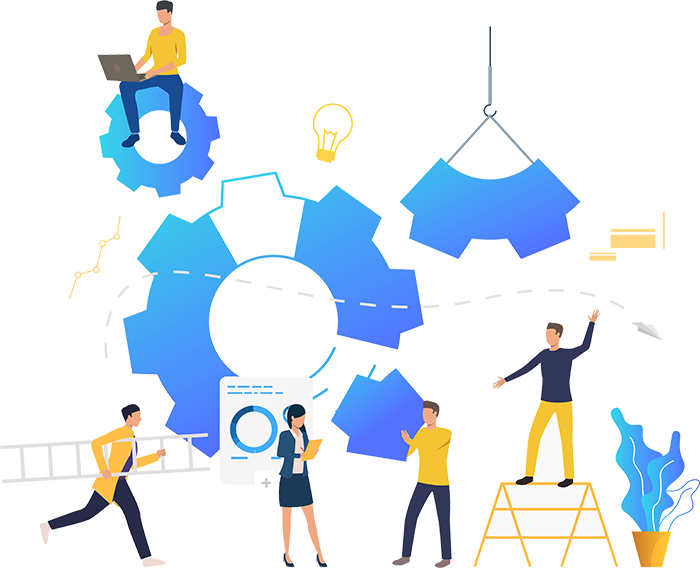
dreams into reality
We Provide
Best Web Development Services
In today’s digital age, a powerful online presence is non-negotiable for businesses aiming to thrive. At BrandCoreInsight, we understand the significance of a well-crafted website, and we’re here to transform your vision into a captivating and functional reality.
- Website Development
- Web Application Development
- Front-end Development
- Back-end Development
- Content Management Systems (CMS)
- E-commerce Development
- Mobile App Development
- Maintenance and Support
- Database Management
- SEO (Search Engine Optimization)
- Security
- Consulting and Planning
What’s the process
Series of steps that developers follow to create a website or web application.

Planning
Create a project plan outlining timelines, milestones, and tasks.
Decide on the technologies and tools to be used. Plan for scalability, security, and future updates.

Design
Develop wireframes or prototypes to visualize the layout and user interface.
Create a design for both the user interface (UI) and user experience (UX).
Decide on color schemes, fonts, and overall aesthetics.

Development
Write the code using appropriate programming languages (HTML, CSS, JavaScript, etc.). Develop the front-end (client-side) and back-end (server-side) components. Implement database structures if needed. Ensure the website is responsive and works across different devices.

Testing
Conduct unit testing to check individual components.
Perform integration testing to ensure different parts work together.
Carry out user acceptance testing (UAT) to validate the system against user requirements.
Test for security vulnerabilities and performance issues.

Debugging and Optimization
Identify and fix any bugs or issues. Optimize code for better performance. Ensure proper error handling.

Maintenance and Updates
Monitor the website for performance, security, and other issues.
Implement regular backups.
Update content and features as needed.

Web development encompasses a wide range of skills and technologies that are used to create and maintain websites or web applications. Here are different aspects of web development:
- Front-end Development:
- HTML (Hypertext Markup Language): The standard markup language for creating web pages and web applications.
- CSS (Cascading Style Sheets): Used for styling and layout of web pages, enhancing the visual presentation.
- JavaScript: A programming language that enables dynamic content, interactivity, and client-side functionality in web browsers.
- Back-end Development:
- Server-Side Languages: Such as PHP, Python, Ruby, Java, Node.js, etc., used to handle server-side logic and interact with databases.
- Databases: Storage systems like MySQL, PostgreSQL, MongoDB, etc., to store and manage data.
- Server Environment: Setting up and configuring servers, often using technologies like Apache, Nginx, or cloud services like AWS, Azure, or Google Cloud.
- Full-Stack Development:
- Involves expertise in both front-end and back-end development, allowing developers to work on all aspects of a web application.
- Web Frameworks:
- Front-end frameworks like React, Angular, Vue.js for building user interfaces.
- Back-end frameworks like Django (Python), Ruby on Rails, Laravel (PHP), Express.js (Node.js) to streamline server-side development.
- Responsive Design:
- Ensuring websites and applications work well on a variety of devices and screen sizes.
- Web Performance Optimization:
- Techniques to improve the speed and efficiency of websites, including image optimization, code minification, and caching.
- Version Control/Git:
- Managing and tracking changes in code, enabling collaboration among developers.
- Web Security:
- Protecting websites from common vulnerabilities, such as cross-site scripting (XSS), SQL injection, and ensuring data privacy.
- APIs (Application Programming Interfaces):
- Creating and consuming APIs to enable communication between different software systems, often using RESTful or GraphQL interfaces.
- Content Management Systems (CMS):
- Platforms like WordPress, Drupal, or Joomla for building and managing digital content.
- Testing:
- Writing and executing tests for different components of a web application to ensure functionality, performance, and security.
- DevOps:
- The integration of development and operations, involving practices like continuous integration, continuous deployment, and infrastructure as code.
- Progressive Web Apps (PWAs):
- Web applications that use modern web capabilities to provide a native app-like experience, including offline functionality and push notifications.
- Web Accessibility:
- Designing and developing websites to be accessible to people with disabilities, following guidelines like WCAG (Web Content Accessibility Guidelines).
- UI/UX Design:
- Creating visually appealing and user-friendly interfaces, understanding user behavior and psychology.
Web development is a dynamic field, and developers often need to adapt to new technologies and trends to stay current in the industry.
Testimonials
What Our Client’s Say






Cum et essent similique. Inani propriae menandri sed in. Pericula expetendis has no, quo populo forensibus contentiones et, nibh error in per. Vis in tritani debitis delicatissimi, error omnesque invenire usu ex, qui illud nonumes ad.
Cum et essent similique. Inani propriae menandri sed in. Pericula expetendis has no, quo populo forensibus contentiones et, nibh error in per. Vis in tritani debitis delicatissimi, error omnesque invenire usu ex, qui illud nonumes ad.
Get A Free Quote
Elevate your online presence with our bespoke web development solutions. Join us to get excellence in code, creativity in design – your website, your success story




